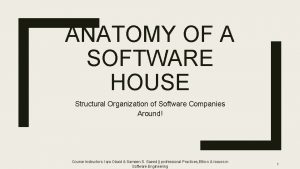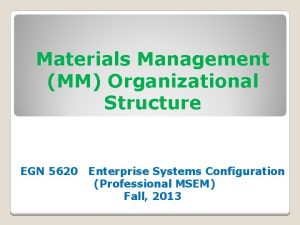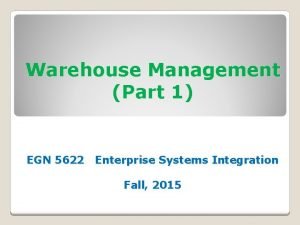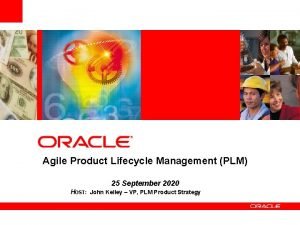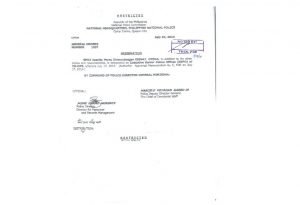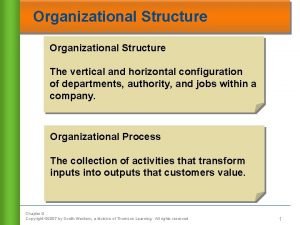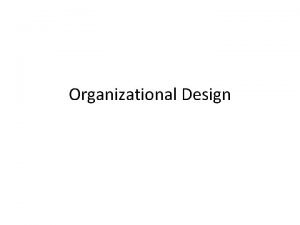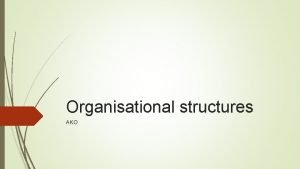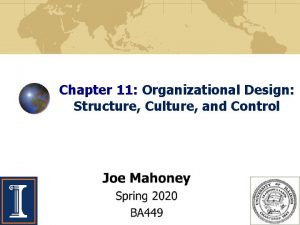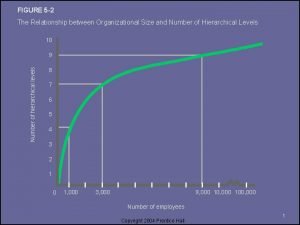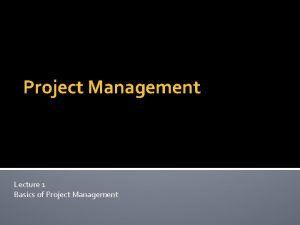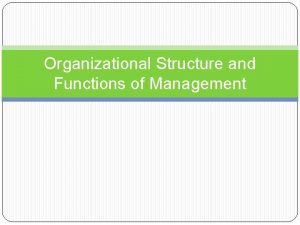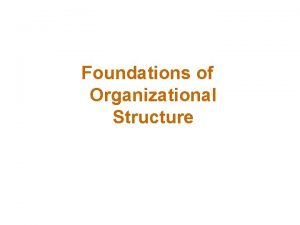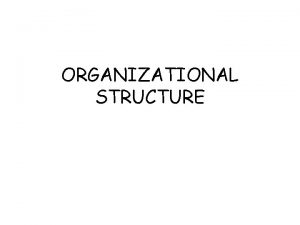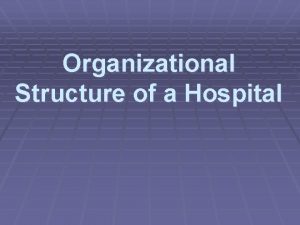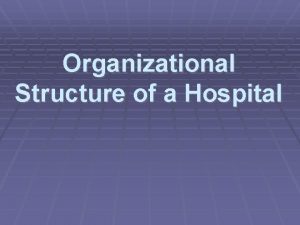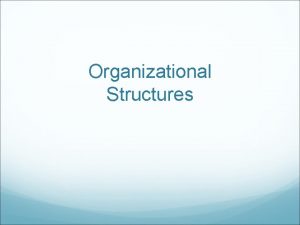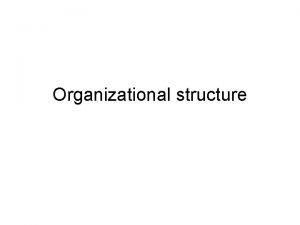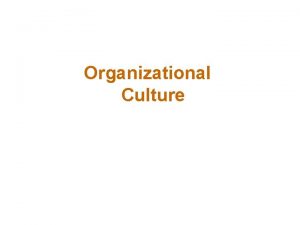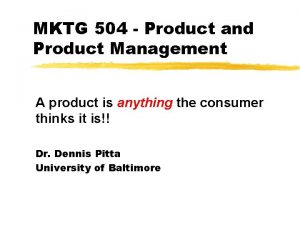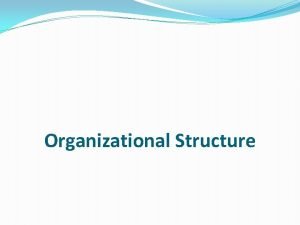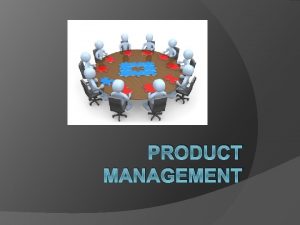Software Product Management Organizational Structure and Productization Lecture










































- Slides: 42

Software Product Management Organizational Structure and Productization Lecture 17 Sjaak Brinkkemper Garm Lucassen 1 Juni 2017


Outline • Organizational growth and structures • Positioning the product manager • Productization from a service firm to a product business

Growth phases Phase 1 Phase 2 Phase 3 Phase 4 Phase 5 Startup Survival Success Expansion Optimal Size Large Small Age of the organisation Young Grown From: Churchill, N. C. en V. L. Lewis (1983), The five stages of small business growth, Harvard Business review, May-June, pp 30 -50.

Characteristics of phases • Startup: first release, first customers, arranging company • Most startups • Survival: second release, getting • Fosbury, Nubiko, Eitri more customers, hiring first employee, create cashflow • Success: more customers, exposure in market • AFAS, Quinity, Mendix • Expansion: redefining the company, hiring personnel, internationalization, company exit strategy • Planon, Tom • Optimal: customer satisfaction • Exact, Unit 4

Structuring an organization 6

Structuring an organization 7

Structuring an organization 8

Baan R&D Department Chief Technology Officer Common Technologies Finance/Legal Product Management HRM Release Management Common Architecture Processes Back. Office Applications Emerging Applications Acquisitions Product Delivery Research ERP Financials Configuration Management Baan. Tech Service& Project CRM Product Testing Workflow E-ERP Supply Chain Multi-Byte Business Intelligence Application Integration Product Assembly Localizations Documentation and Training The organizational structure of Baan R&D Department in 1998; 1500 employees

Organizational structures are needed because – Growing organisations need functional specialists – Management has limits in numbers Categories: F: Functional HRM, Development, Sales, Marketing, … P: Product ERP, Middleware, BIS, Localizations, … M: Market Large accounts, SME, Public, Banking and Insurers, … G: Geografic Benelux, Nordic, UK, France, …

Standard F-structure Board R&D Marketing Sales Services Support

Investments and profits Board - - R&D + Marketing Profit: + Sales S + Services S - + Support

Substructures Board R&D P-structure Marketing Generic, P-structure Sales P-structure G-structure M-structure Services Support P-structure

P-type for R&D mgr Product Management Product 1 Product 2 Architecture Board Product 3 Product 4 • R&D departments are responsible for a product line • Product Management: • Functional responsibility • Liaison with Marketing • Architecture Board • Technical responsibility • Interfacing of products

Discussion • What is the stage of your assignment company? • Do you have insight in their organizational structure?

Outline • Organizational growth and structures • Positioning the product manager • Productization from a service firm to a product business

Position product management • The positioning of Product Management determines – – – Responsibilities Activities External and internal communications Five positioning scenarios 1. Within R&D: as overall function When functional integration of products is essential 2. Within R&D: inside product development teams When products are relatively independent 3. Within Marketing When customer value and market presence are important 4. Partly within Marketing and partly within R&D When customers have complex technical requirements 5. Under the Board When CEO/CTO are heavily involved in product functionality

Organizational variability Board Product Management R&D Marketing Product Management Product 1 Product Management Sales Services Marketing Communication Product Management Product 2 Product Management Product 3 Product Management Quality & Delivery Support

Discussion • What is the position of the product manager in your assignment company?

Outline • Organizational growth and structures • Positioning the product manager • Productization from a service firm to a product business

Introduction on Productization • Productization: from project/customer driven to product/market driven business • IT Service firms have difficulty managing product business – Project: billable hours, project acquisition – Product: market share, next release launch – Spin-off of Acision from Logica • Earlier study Productization from within one company (Artz et al. 2010) • Research question To what extent is the productization process applicable in an IT service firm when transforming from developing customer specific software solutions to standard product software for a market?

Generic view on productization

Towards product organization Product Organization No Product Organization Customized Standardized

Research approach • • • Invitation by IT service company Case study: theory testing 7 products selected from candidate set Literature background Semi-structured interviewing Determination of initial position Gap analysis Advise to case study firm Overall findings

Productization process 1. 2. 3. 4. 5. 6. Independent projects Reuse across projects Product recognition Product basis Product platform a. Customizable product (enterprise solution) b. Standard product (packaged mass-market) Artz et al (2010)

Productization Process 2/2 Two end stages: For some software there is a need for customization in order to integrate software in a customer-specific situation Aspects of productization (Hietala et al. , 2004) - Product market - Concepts - Benefits - Positioning - Selling - Marketing Degree of standardization adopted from Hoch et al. , 1999

Literature: Dimensions of Productization

Focus dimensions Dimensions Customized software Software Customized software project Standard software product Meeting the customer needs within budget and time, contractual Gaining market share fulfillment Business focus Requirements gathering Requirements selection Marketing goals Gathered from one customer Select requirements per project (More or less fixed list of requirements) Interaction, relationship and networks Standard software Gathered from whole market Optical selected subset of requirements Product, price, place and promotion (4 P’s), branding and differentiation Software development philosophy Waterfall SCRUM agile development Lifecycle One release, then maintenance Several releases based on market requirements Development teams Project focused, people are assigned to multiple projects Product-focused, self-managed, Involved in the entire development cycle Stakeholder involvement High external, barely internal High internal, low external

Productization process 1. 2. 3. 4. 5. 6. Independent projects Reuse across projects Product recognition Product basis Product platform a. Customizable product (enterprise solution) b. Standard product (packaged mass-market) Artz et al (2010)

Project Portfolio Customer Project 1 Software Custom features Customer Project 2 Software Custom features Maintenance Delivery Requirements Engineering Customer Project 3 Software Custom features Customer Project 4 Software Custom features Maintenance Delivery Requirements Engineering Stage 1: Independent projects • Independent relations between projects. • Projects differ in budget, technology, and functionality

Project Portfolio Customer Project 1 Software Custom features Standard features Maintenance Delivery Requirements Engineering Customer Project 2 Software Custom features Standard features Customer Project 3 Software Custom features Standard features Customer Project 4 Software Custom features Standard features Maintenance Delivery Requirements E ngineering Delivery Requirements Engineering Stage 2: Reuse across projects • Focus on feature reuse across projects • More custom than standard Maintenance Delivery Requirements Engineering

Product Portfolio Customer Project 1 Software Customer Project 2 Software Customer Project 3 Software Portfolio management Customer Project 4 Software Standard features Custom features Standard features Maintenance Delivery Requirements Engineering Custom features Standard features Custom features Stage 3: Product recognition • Shared features between projects • More standard than custom • Introduction of portfolio management Standard features Custom features

Product Portfolio Customer Project 1 Software Customer Project 2 Software Standard features Customer Project 3 Software Portfolio management Customer Project 4 Software Standard features Custom features Maintenance Delivery Requirements Engineering Stage 4: Product basis • Generic product platform • Introduction of product roadmapping • Customer specific maintenance Product Roadmapping

Product Portfolio Customer Project 1 Software Standard features Customer Project 2 Software Standard features Customer Project 3 Software Portfolio management Customer Project 4 Software Standard features Custom features Releases Delivery Delivery Customer Requirements Stage 5: Product platform • Increasing generic product platform • Introduction of requirements management • Requirements gathering based on market trends • Event based customized releases per customer Product Roadmapping Requirements Management

Product Portfolio Customer Project 1 Software Standard features Customer Project 2 Software Standard features Customer Project 3 Software Portfolio management Customer Project 4 Software Standard features Custom features Releases Launch & delivery Market. Requirements Market Requirements Stage 6 a: Customizable product software • • • One standard product with small additional customized layer Introduction of release planning Structured standardized releases Customer requests are handled as market requirements Product software aiming at selling services Product Roadmapping Release Planning Requirements Management

Product Portfolio management Market Product Customer Project 1 Product Standard features Customer Project 2 Product Standard features Customer Project 3 Product Customer Project 4 Product Standard features Releases Launch & delivery Market Requirements Stage 6 b: Standard product • • • One generic product for all customers and build for a specific market Introduction of release planning Structured standardized releases Software is completely configurable Product software aiming at selling licenses Product Roadmapping Release Planning Requirements Management

Case studies • 7 theory testing case studies • Varying interviewees • Service perspective (project mgr, delivery mgr) Potential products Market sector Product A Telecom market Product B Telecom, Transport and Utility Product C Local government Product D Utility firms Product E Oil Companies Product F Local government Product G Local government

SPM Maturity Matrix Focus area Market analysis Partnering & contracting Product lifecycle management Roadmap intelligence Core asset roadmapping Product roadmapping Requirements prioritization Release definition validation Scope change management Build validation Launch preparation Requirements gathering Requirements identification Requirements organizing 0 1 2 3 4 Portfolio management A Product planning A A A B Release planning A B A B C A A B Requirements management A B C A A 5 6 7 8 9 10 A B B B C D C C D D E E E B C D D C E E D C B C D D B C B D E E C D C E F B B D E C C F D

Maturity results Focus area Advanced (2) Emerging (5) Avg(%) Portfolio management 21, 9 14, 2 16, 4 Product planning 19, 3 15, 3 16, 5 Release planning 45, 6 24, 7 30, 7 Requirements management 41, 7 22 27, 6

Discussion • Language and vocabulary problems due to service versus product perspective • SPM maturity assessment interpreted differently: make SPM more SMART • Service firm finds Productization difficult due to different business model and culture • Focus on IP creation and buy-out

Conclusions • Validation of productization process • Immaturity of product business inside a service business • Many advises for service company to arrange product teams • But then the IT service firm got acquired …

Questions?
 Software product lines
Software product lines 01:640:244 lecture notes - lecture 15: plat, idah, farad
01:640:244 lecture notes - lecture 15: plat, idah, farad Software project management handwritten notes pdf
Software project management handwritten notes pdf Software house structure
Software house structure Material management organization structure
Material management organization structure Vertical
Vertical Sap wm organizational structure
Sap wm organizational structure Product lifecycle management agile
Product lifecycle management agile Project planning and management lecture notes ppt
Project planning and management lecture notes ppt Requirement analysis in software engineering notes
Requirement analysis in software engineering notes Lecture presentation software
Lecture presentation software Product life cycle kotler
Product life cycle kotler Central idea of the production
Central idea of the production Depth of product line
Depth of product line What is industry/target market feasibility analysis
What is industry/target market feasibility analysis Domestic product and national product
Domestic product and national product Pnp structure
Pnp structure Horizontal configuration
Horizontal configuration Software organization structure
Software organization structure Difference between tall and flat organization
Difference between tall and flat organization Johnson and johnson organizational structure
Johnson and johnson organizational structure Sbu m-form structure
Sbu m-form structure Organizational design: structure, culture, and control
Organizational design: structure, culture, and control Strengths and weaknesses of flat organizational structure
Strengths and weaknesses of flat organizational structure Multidomestic strategy pros and cons
Multidomestic strategy pros and cons Improving software economics set 1
Improving software economics set 1 Change and stress management
Change and stress management Information resources
Information resources Organizational theory and management
Organizational theory and management Project procurement management lecture notes
Project procurement management lecture notes Strategic management lecture
Strategic management lecture Project management lecture notes doc
Project management lecture notes doc Financial management lecture
Financial management lecture Public sector accounting notes
Public sector accounting notes Operations management lecture notes doc
Operations management lecture notes doc Performance management lecture
Performance management lecture Human resources department structure
Human resources department structure Chapter 1 introduction to human resource management
Chapter 1 introduction to human resource management Human resource management lecture chapter 1
Human resource management lecture chapter 1 Project cost management lecture notes
Project cost management lecture notes Project management lecture
Project management lecture Unified health management information system
Unified health management information system Risk management lecture
Risk management lecture



